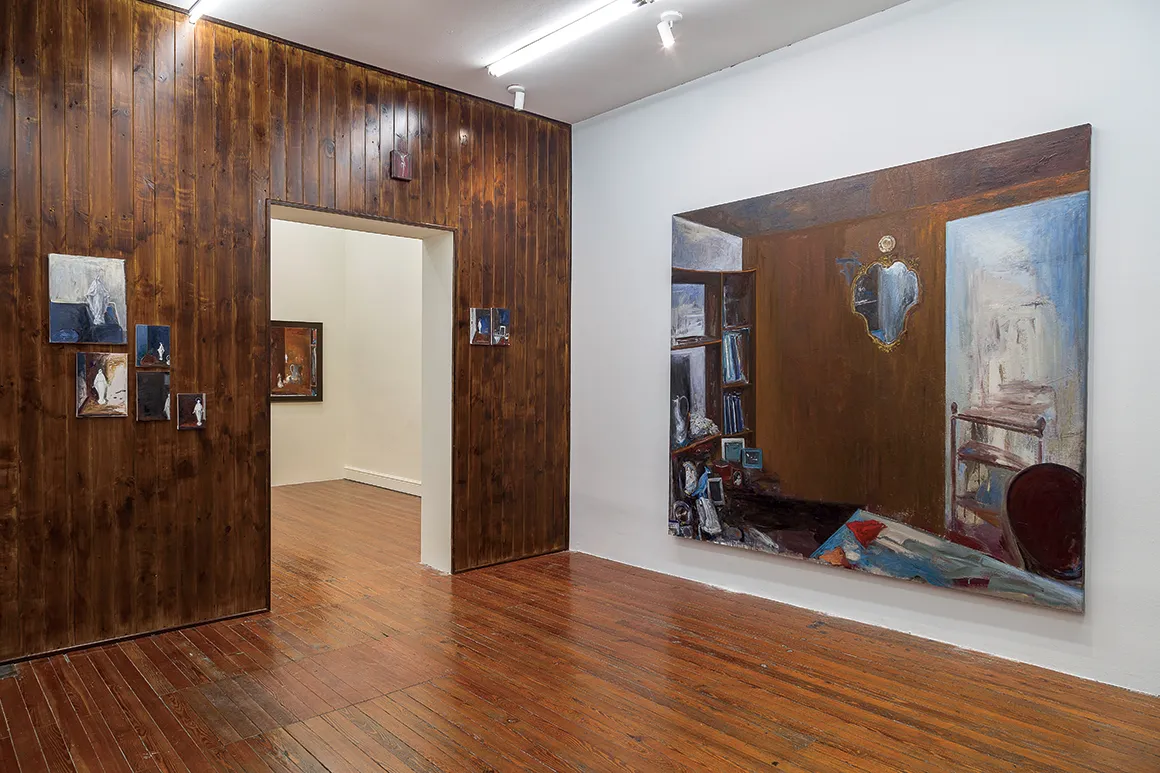
Carlos Cima
La revista Artforum visitó la exhibición "Ezeiza", del artista plástico Carlos Cima, profesor del Departamento de Arte.

At first, the paintings in Carlos Cima’s exhibition “Ezeiza” look like pieces of the hallway of an apartment, an organized but jammed and somewhat airless setting in shades of dark brown and blue. A horizontal painting of a sword (Inheritance, all works 2023) in quivering browns hung at the entrance just above eye level, the way historical swords serve as wall decor and household emblems of power and protection. The gallery walls were painted in warm creams and cool light blues. A wood-paneled wall with a door-like opening had been added to divide the space and lend it an even more domestic air; it evoked the prefabricated veneers that were so popular in the 1970s: an inexpensive yet “tasteful” ersatz. The paintings, all in oil on canvas and ranging in scale from less than eight inches to about six and a half feet, appeared in unbroken morphological continuity with the wall, creating a labyrinthine interior encompassing the visitor. Behind the wall and through the opening, three large-scale paintings featured an abandoned living room in three different angles—one recognized the depicted space only on second or third look—into which the visitor could seemingly step, if only one could find the way.
The slightly stuffy interiors depicted in Cima’s paintings, cramped with heavy wooden furniture, family memorabilia, framed photographs, empty vases, or Catholic devotional miniatures, is said to be typical for the conurbano,the ring of suburban municipalities that surround the capital city of Buenos Aires, home to a quarter of Argentina’s inhabitants. The suburban-urban divide has played a major role in the country’s permanent political-economic crises. These interiors are also a private mise-en-scène for Cima (born in 1990 in Buenos Aires), who grew up in the Ezeiza Partido, known for a large federal prison complex where many of his family members work. One can imagine the scenario in these rooms—perhaps a return home to vacate its contents after a move-out or death. Intimacy is mixed with disgust; a scrutinizing gaze is implicated with compassion. Death erupts out of layers of dust and cellophane bags, clinging to its presence in life.
Cima’s paintings are nourished by the tension between the avant-garde art of the ’60s and ’70s—painting that presents and is concerned with its own objecthood and making—and the local, peripheral, eclectic material culture in which he grew up. He paints with a tender yet distanced gaze and a confident rough brush that often shifts into monochromatic abstract surfaces. Kitsch, that degraded variation of romanticism that floods the world to satisfy popular taste and cater to a desire for stability, serves the artist more as a vehicle for melancholy than for analysis and demonstrates the hold such imagery has on us.
Like a camera lens, Cima returns to the same object or scene from different angles and in different proximities. And despite the pervasiveness of frames in the paintings—one of them (Untitled, like most of the works in the show) features a framed photograph mounted in a wood-and-glass frame and showing the artist as a child with his father—the painted image always seems to be cropped rather than framed. The old rivalry between painting as object and painting as image is settled here in an awkward harmony.
While photography unifies all that it captures on one surface, Baroque painting (starting with Caravaggio) was more concerned with suggesting depth in the painting and a dramatic peak, initially the last ray of light structured through diagonals that cross the painted darkness. Such rays of light (recalling especially Georges de La Tour and Francisco de Zurbarán) fall in Cima’s paintings upon ordinary objects and let them beam against a dark ground, analogizing the trivial with the sacred. An old push-button phone and a miniature of the Virgin hung back-to-back on the opposite sides of the wall; a tiny canvas showing a white Christ against a bloodred background adorned its opening from above.
Link: https://www.artforum.com/events/tal-sterngast-carlos-cima-constitucion-galeria-2024-557835/
